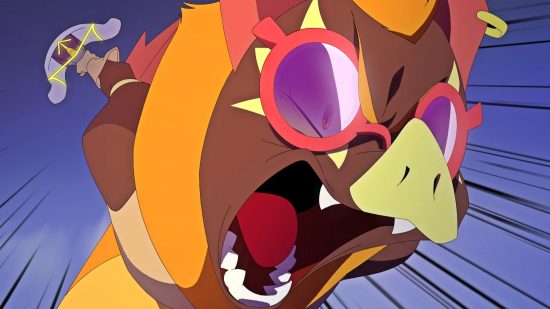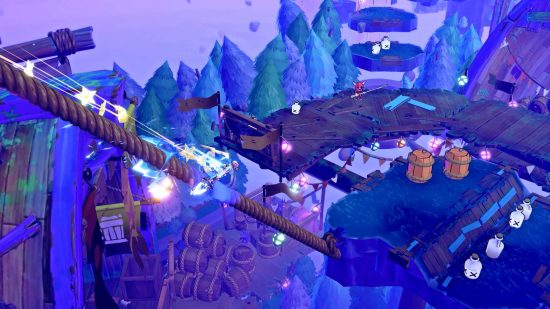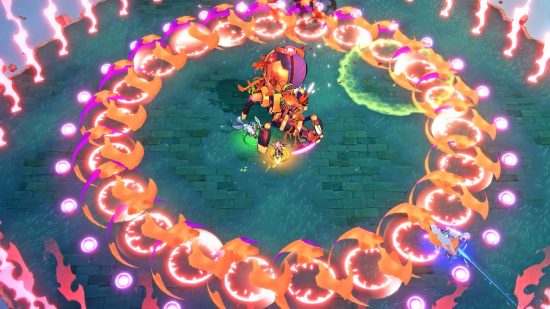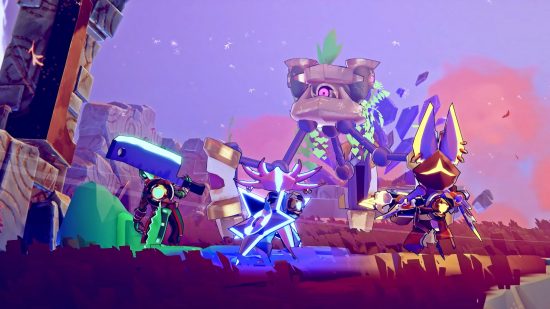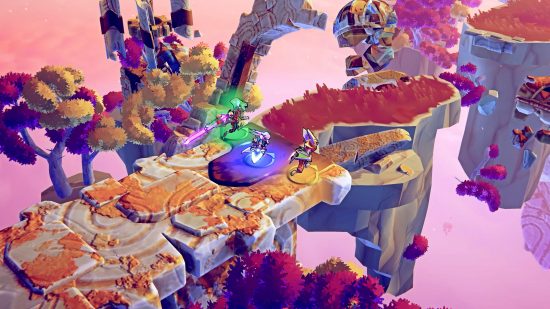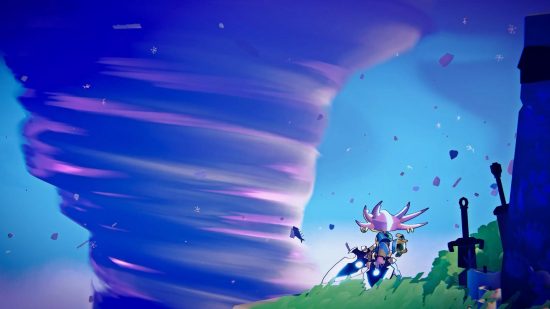Indie darling Dead Cells is a firm favorite in the roguelike fan circle here at PCGamesN, so it should come as little surprise that we’ve been dying to get up close and personal with developer Motion Twin’s latest project since it was announced back at The Game Awards last year. We caught up with Motion Twin developer Yannick Berthier and artist Thomas Vasseur at GDC for our first look at Windblown, and discovered how the studio plans to push forward its acclaimed action roguelike formula in cooperative play.

While its presentation may appear drastically different on the face of it, the fast pace of Dead Cells translates into an isometric perspective that has Windblown’s cast of anthropomorphic Leapers dashing across platforms at a breakneck pace. “It’s not about speed,” Berthier clarifies. “Speed is a way to get into a state of flow. It’s what we were doing in Dead Cells, but we’re just pushing that with another dimension in multiplayer.” However, there’s no question that Windblown’s momentum leaves it primed for roguelike game speedrunners.
“We really wanted to have a fast-paced game that we can play together,” Berthier explains. “We did find great games to play together that were a bit slow and games to play at lightspeed like Devil May Cry. But the merge between the two, we didn’t have that.” Bethier and Vasseur tell me that Windblown’s difficulty constantly changes, though community feedback and suggestions in the closed alpha and Discord server help Motion Twin to strike that perfect balance across a wider audience – particularly given the development team is only nine strong.
There’s plenty of verticality to Windblown’s procedural maps that leave room for more laidback players to explore at their own pace. “It’s not an open world where you can go everywhere,” Berthier clarifies. “There is a main path and you have a few branches, but you do also have secrets behind walls, waterfalls – because they are made for secrets.” He also teases the potential for hidden biomes, and this Metroidvania streak is sure to satisfy Dead Cells fans. Currently, there are five biomes in total, including alternate versions of the first biome that are unlocked later to keep things fresh. “In the long run, what we want is to create dozens of biomes and create branches and something way more complex, like Dead Cells,” Berthier explains.
The procedurally generated islands floating in the Vortex might be a literal world away from the painterly style of Dead Cells’ 2D environments, but the saturation of color running through it feels familiar. There’s only a moment to take in the scenery before the mechanical Vortex Sentinels appear in their droves, and the true Windblown experience begins.
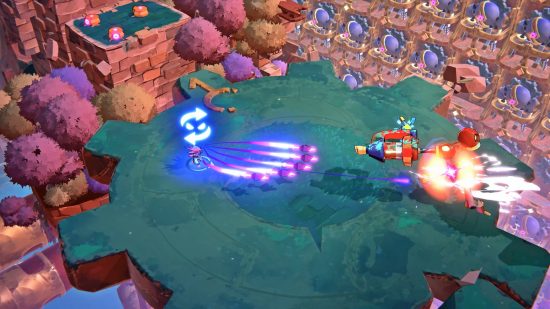
“The combat is still pattern-based, so you need to read what the monsters will be doing,” Berthier explains. “Every one of them has its own unique moves and ways to react to how you’re playing.” I get a live demonstration of this combat rhythm as Berthier takes on the more formidable bosses that have emerged from the Vortex. Instead of charging headlong into battle, he adopts a more defensive approach and goads them into attacking first. This split-second opening allows him to dodge out of harm’s way and dole out a hefty punishment with a comically large sword.
Of course, it’s not always about the size of your sword, it’s what you do with it. “In Windblown, the critical system is not randomized. Each weapon has its own way to do critical [damage],” Vasseur explains. One such weapon only deals critical damage when attacking enemies from behind, while another depends on executing a jump attack. Thankfully, these weapons also come with bonus moves to find that ideal position. “Every weapon has a hidden attack that we call the Alter Attack,” Vasseur says. “To unleash it, you have to use the other weapon equipped.” Given that there are currently 11 weapons in the indie game, that leaves players with a lot of combinations to discover.
“It’s definitely inspired by games like Monster Hunter. You need to know your weapon to dash less and to deal more damage,” Vasseur says. Naturally, this becomes a tougher prospect as more enemies appear on the scene. The platform arena descends into carefully controlled chaos with a bullet hell flair, as Vasseur navigates projectiles and other attacks just to stay alive. “We played too much Nier Automata,” Berthier laughs.
As Dead Cells fans can attest, having a bigger stick than the other guy is half the battle. The bulk of Windblown’s build synergy lies in the gifts bestowed by fallen Leapers, which grant random passive skills. Berthier and Vasseur liken Windblown’s reward system to Binding of Isaac and other traditional roguelikes that incorporate an element of surprise as players discover item synergies that can make or break a run. “It’s fine to not be fully balanced and to sometimes have overpowered builds. For us, it’s a good sign actually,” Berthier says. “Those are the ones we remember, even though they’re not the most balanced.” He also tells me that the community is quick to flag builds that are so extreme as to break the game: “They’re way more efficient than us at finding those.”
Berthier tells me that the latest closed alpha build contains 40 gifts, though that number will expand to 50 in the next version. When I ask how gifts would be divided among players in co-op, it’s surprisingly straightforward: in instances where players must choose from a set of rewards, each player can make their own choice, whereas item drops are shared among the group. You can also see each other’s choices and strategize together. Aside from external voice chat software, players can communicate with each other through emotes. “We do want to have voice chat in-game,” Berthier says, though text chat is a more complicated prospect. “We don’t want people to be uncomfortable. Maybe it will come later on because we might need some filters.”
Even the most well-loved roguelike build can gain a new lease of life in Windblown’s multiplayer, as players can exploit abilities that their teammates unleash on the battlefield – or prematurely trigger them with a mistimed dodge. “We need to have this social friction to have the ‘dream team’ effect,” Vasseur explains, but this friction works both ways. Players might drop items on the floor to help a teammate, but that doesn’t stop another from swooping in to ninja loot. While Berthier clarifies that ninja-looting doesn’t extend to meta-progression items and permanent upgrades, it adds weight to choices players make in cooperative – you have to be really sure you want to drop your old weapon in favor of a new one, otherwise you might never get it back. “If there’s no friction, it’s pointless,” Vasseur adds. “It’s like you’re playing with bots.”
Windblown’s revival system also plays its part in this ethos, and it’s one that Dead Cells enthusiasts may find familiar. “When someone dies, the survivors are cursed,” Vasseur explains. “The goal for survival is to kill enemies in order to make the curse disappear, and when it does, everybody is revived.” This is prime real estate for clutch moments, and Motion Twin hopes that such high stakes will keep fallen teammates engaged with the run. “We wanted to avoid moments like in a Counter-Strike match where suddenly you die and you’re just waiting for the counter and what [your teammates] do doesn’t have much of an impact on you,” Berthier explains.
Naturally, Windblown is a roguelike, so it comes as little surprise that every run in this hands-off preview ends in premature death. However, it’s also the perfect opportunity to see the permanent upgrades available back at the Ark – the floating hub area that serves as your home refuge, which is also on the cusp of being swallowed by the Vortex. “You do have stuff that makes you a bit stronger, especially at the beginning of the game,” Berthier explains, “but most of this stuff will change the randomized generation – so new kinds of islands, secrets, and challenges.”
The Ark is also where players are free to switch between character skins at their leisure. At the moment, this choice is purely aesthetic, with no unique skills or passive abilities, though this might change between now and the Windblown release date. “People do ask for that quite a lot,” Berthier concedes. “It might change or not. We need to find the right formula so that not everyone will use that one [character].” There’s a clear freedom in choosing the animal avatar that appeals to you the most – you can prise Windblown’s punk axolotl out of my cold, dead hands – but it also lends a purity to each run, where your odds of success lean more on your weapons and emergent build.
While this ragtag quartet is set to expand over time (Vasseur has a delightful concept for a snake character with prosthetic arms), they’re currently the only giveaway that Windblown was initially intended to be a four-player co-op game. “It was just impossible,” Berthier confesses. “[There was] too much stuff on the screen. Three is really the limit where we can keep it understandable.” On the flip side, Berthier and Vasseur can attest that hopping in as a duo is more than viable – they regularly play together.
Berthier estimates that an average run will take 30 to 40 minutes, while completionists may hit the hour mark. “You can actually exit the game and resume a run wherever you were,” Berthier reassures me, though Vasseur is quick to follow up that this won’t be viable in multiplayer given that the run would likely be over by the time you hop back in. “We try to make it the most convenient as possible while making it maintainable for us, and not become a nightmare of maintenance where we just update core tech and not create new crazy stuff – which is more fun for the player.”
We expect to discover even more in the coming months as development continues and Windblown’s closed alpha slowly opens up to more and more players – you can sign up here for a chance to be invited along for the ride.
In the meantime, we’ve got the very best Metroidvania games you’ll want to try alongside some of the biggest upcoming PC games, too.
